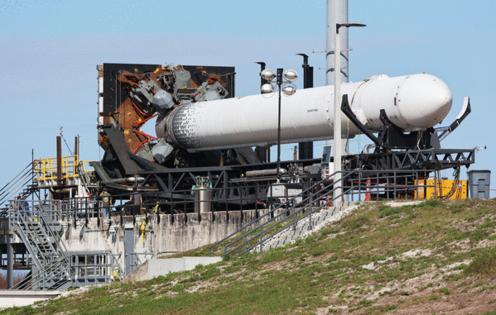
Richard Tribou, Orlando Sentinel on Mar 11, 2023
First came upper-level winds, then a boat crept onto the range, and the engines even ignited at one point for a few seconds, but ultimately Saturday proved to be another scrub for Relativity Space’s 3D-printed Terran 1 rocket from Cape Canaveral Space Force Station.
“We’ve had an abort of the internal count,” said Launch Director Clay Walker with 45 seconds to before the last-ditch attempt to send the rocket up at the end of a three-hour window from Canaveral’s Launch Complex 16. “We are going to scrub for the day, safe up the vehicle. Thanks for playing.”
“Based on initial data review, vehicle is healthy,” the company posted to its Twitter account, then explaining the reasons behind its two countdown scrubs during Saturday’s efforts saying the first was “a corner case in the stage separation automation,” which required an update to the automation, and the final scrub was due to “an automated abort on stage 2 fuel pressure, which was only one PSI low.”
“The team went hard today and we intend to do so during our next attempt. More to come on the new launch date and window soon,” the company posted. The company previously had to take a few days to replenish propellants needed for a launch after scrubbing an attempt on Wednesday as well.
The day started on time with propellant load going well, but windy conditions pushed one opportunity, and then a second chance had to be held for several minutes after a boat entered the Eastern Range in the Atlantic.
Then finally at 2:42 p.m., the countdown clock read 0 as blue flame began to appear on the nine Aeon 1 rocket engines and billows of white smoke surrounded the rocket, but as the smoke cleared, the rocket was still standing on the pad.
Walker said the clock held at 0.5 seconds because of an automated violation of launch commit criteria, but did not state what the issue was.
Despite the scrub, teams assessed the status of the rocket and decided to reset the clock for the final minute of the 1-4 p.m. window, but that last chance ultimately held making the Long Beach, California-based startup company 0-for-2 in its effort to send its first-ever rocket to space.
It had to waive off that first go-around on Wednesday when the cryogenic propellant in the rocket’s second stage violated launch constraints for being too warm causing an automated scrub with 70 seconds left on the countdown clock.
When it does get a third chance, the launch would be the culmination of more than seven years since cofounder and CEO Tim Ellis joined his University of Southern California classmate Jordan Noone on the venture in 2015 having both interned at Blue Origin and Noone working for a time with SpaceX.
“Feels like a lifetime ago, but is an incredibly short time frame in the scheme of things in aerospace,” Ellis posted to Twitter. “Especially starting as two people in a WeWork, truly from scratch, where we had to rally and scrap together every ounce of funding, team, facilities, and technology starting from absolutely nothing. Very hard to believe, and humbling to think, that in those years our incredible team managed to do so much.”
Terran 1 could knock out several firsts if successful on the test flight dubbed “GLHF,” as in “Good Luck, Have Fun,” carrying a symbolic 3D-printed metal object that was one of the company’s first-ever 3D-printed items from the first generation of its Stargate metal 3D printers.
The fuel for Terran 1 is liquid oxygen and refined liquid natural gas close to methane, a combination dubbed “methalox” that has yet to power an orbital rocket. SpaceX’s new Starship, ULA’s upcoming Vulcan and Blue Origin’s in-development New Glenn also will use the mixture. China has also tried, but failed, to send up a rocket using this next-generation fuel.
The rocket is about 85% 3D-printed, and if it flies, it will become the largest 3D-printed object to fly into space.
The company also hopes to make history and actually have a successful first flight of its rocket.
“I have been getting lots of questions about what I’m hoping for on launch day,” Ellis said. “Of course, the rocket-loving engineer in me wants to see us be the first privately-funded and first liquid-propellant rocket to ever reach orbit on the first try. That would be truly unprecedented, especially with all the other ‘firsts’ this launch represents on the global stage. But there are a lot of important moments before that which will have me jumping out of my seat.”
The Terran 1 rocket is smaller compared with SpaceX’s Falcon 9 or ULA’s Atlas rockets, standing at just 110 feet tall. The first stage uses nine Aeon 1 engines with the second stage using a single Aeon vacuum engine. It’s capable of sending 2,756 pounds of payload to low-Earth orbit of about 310 miles, but this test flight is only aiming to hit between 125-130 miles high.
Terran 1 is just the first step in the company’s plans to build out an even larger rocket that would be 95% 3D-printed called the Terran R. which would also have a reusable first stage and could compete with the likes of SpaceX and ULA.
To that end, the company has been hedging its bets in terms of determining how useful today’s launch will be, noting several goals including liftoff from the pad, testing the rocket’s structural integrity while hitting maximum dynamic pressure, stage separation and the ignition of the second-stage engine with ultimately a succesful orbital insertion.
“As a customer-focused launch services company, we aren’t truly in charge of defining success for this launch. Our customers will really be our deciding jury,” Ellis said. “The goal is to provide our customers with confidence in us and our abilities, especially with $1.65 billion in customer launch contracts already signed overwhelmingly for our larger reusable rocket Terran R, and billions more in our pipeline.”
©2023 Orlando Sentinel. Visit orlandosentinel.com. Distributed by Tribune Content Agency, LLC.














